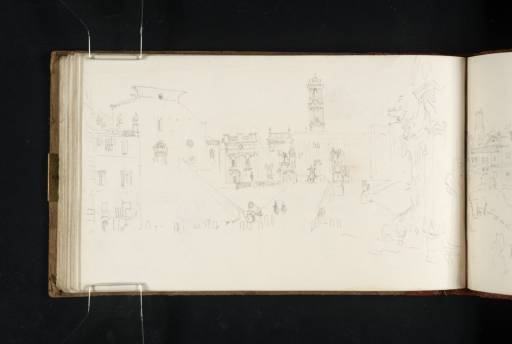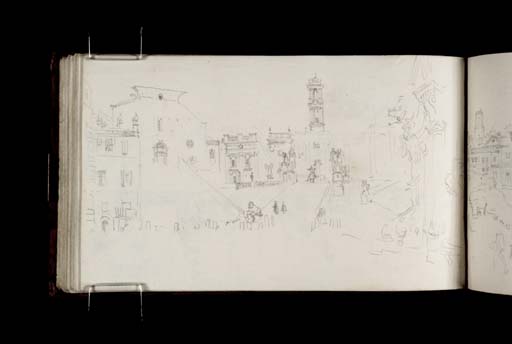Joseph Mallord William Turner Santa Maria in Aracoeli and the Campidoglio on the Capitoline Hill, Rome 1819
Image 1 of 2
Joseph Mallord William Turner,
Santa Maria in Aracoeli and the Campidoglio on the Capitoline Hill, Rome
1819
Joseph Mallord William Turner 1775–1851
Folio 57 Verso:
Santa Maria in Aracoeli and the Campidoglio on the Capitoline Hill, Rome 1819
D15404
Turner Bequest CLXXXII 56 a
Turner Bequest CLXXXII 56 a
Pencil on white wove paper, 113 x 189 mm
Inscribed by the artist in pencil ‘3’ and ‘3’ centre, to right of each of the statues of the Dioscuri
Accepted by the nation as part of the Turner Bequest 1856
References
1909
A.J. Finberg, A Complete Inventory of the Drawings of the Turner Bequest, London 1909, vol.I, p.538, ‘Façade of the Senatorial Palace on the Capitol’.
1984
Cecilia Powell, ‘Turner on Classic Ground: His Visits to Central and Southern Italy and Related Paintings and Drawings’, unpublished Ph.D thesis, Courtauld Institute of Art, University of London 1984, p.117, reproduced pl.61, as ‘The Campidoglio and S. Maria in Aracoeli’.
1987
Cecilia Powell, Turner in the South: Rome, Naples, Florence, New Haven and London 1987, p.[43], reproduced pl.52, as ‘The Campidoglio and S. Maria in Aracoeli’.
Turner’s viewpoint for this drawing is the bottom of two famous flights of steps in Rome: on the left the Aracoeli Staircase, leading up towards the Church of Santa Maria in Aracoeli; and in the centre, the Cordonata, the wide ramp designed by Michelangelo to link the Piazza Venezia to the Piazza del Campidoglio. Where the two staircases meet at the bottom, Turner has drawn one of the two Egyptian lions which flank the entrance to the Cordonata, whilst at the top, he has depicted the Dioscuri, a pair of classical male nudes each holding a horse which represent the twin sons of Jupiter, Castor and Pollux. As Finberg identified, in the centre of the sketch is the façade of the Palazzo Senatorio (Senatorial Palace) outlined with Turner’s typical economy including architectural details on one half of the building only. The artist does, however, include the ancient bronze equestrian statue of Marcus Aurelius placed in the centre of the piazza by Michelangelo.1 Cecilia Powell has argued that certain elements about the sketch indicate that Turner must have executed the study from several different places.2 The rooflines of the palaces appear more continuous than they really are whilst the area seems less congested. The houses visible to the left of Santa Maria in Aracoeli were demolished at the end of the nineteenth or beginning of the twentieth century in order to make way for the building of ‘Il Vittoriano’, the large monument to Vittorio Emanuele II (1820–1878), the first King of a united Italy.
This view is one of a number of established motifs which formed a repertory of Roman subjects inherited from the ‘vedute’ tradition. For example, the composition is very similar to Piranesi’s treatment of the same subject in the engraved series, Veduta di Roma, (1748–78).3
Nicola Moorby
May 2008
How to cite
Nicola Moorby, ‘Santa Maria in Aracoeli and the Campidoglio on the Capitoline Hill, Rome 1819 by Joseph Mallord William Turner’, catalogue entry, May 2008, in David Blayney Brown (ed.), J.M.W. Turner: Sketchbooks, Drawings and Watercolours, Tate Research Publication, December 2012, https://www


